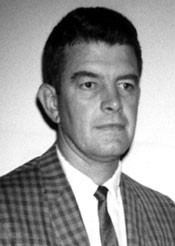George L. Trigg
DOI: 10.1063/PT.3.2728
George L. Trigg, assistant editor and then editor of Physical Review Letters (PRL) from 1958 through 1988, died on 24 June 2014 in Pennington, New Jersey. From the very beginnings of the journal, Trigg played a crucial role in setting its character and establishing it as one of the world’s preeminent and timely physics journals.

George L. Trigg
AIP ESVA, PHYSICS TODAY COLLECTION

In response to the post–World War II burgeoning field of physics, Samuel Goudsmit, then editor of Physical Review, conceived the idea of converting the Letters to the Editor section into a heftier, separate publication. He was quick to identify Trigg as the person to get it off on the right foot. He easily convinced Trigg to take leave of his professorship at Oregon State College (now University) and then, after a short time, to accept the permanent editorship at PRL.
The new journal was confronted with two basic challenges. The first was to rethink the publication process itself. Physical Review, sometimes semi-affectionately called the Green Plague because of its cover color and its ever-increasing size, had a carefully organized publication process involving hot type that, while accurate and readable, was also time consuming to prepare—a property not conducive to the new journal’s need for rapid publication. Trigg was instrumental in devising a speedier technique that used skilled typists and some specially designed typewriter keys for the abundant and convenient use of symbols. The time frame for publication was thereby reduced to what would eventually become an insignificant portion of the total editorial and production time.
The second challenge faced by PRL was to reduce the time it took to undergo the peer-review process. In the early days, Goudsmit and Trigg, in consultation with Brookhaven National Laboratory colleagues, handled both editorial and peer-review processes pretty much by themselves. Formal refereeing gradually developed and, as the journal acquired ever more prestige and status, eventually became the determining submission-to-publication time factor. Trigg shepherded the journal through that adolescent period with his cool and steady hand.
During his approximately 30-year tenure as assistant editor and editor, Trigg managed to publish, either alone or with colleagues, more than 60 editorials. Written in his pithy style, many of them were motivated by his never-ending quest to educate his authors on the fine points of proper scientific writing, with occasional reports on the need to control the size and quality of the journal. While, of course, many individuals contributed to the success of PRL, the unique role played by Trigg was possibly its most critical factor.
Probably the most famous of Trigg’s editorials was his spoof on style, entitled “Grammar,” which appeared in PRL on 19 March 1979 (volume 42, issue 12, page 747).
Trigg was born on 30 September 1925. He received his BA, MA, and PhD degrees from Washington University in St. Louis. His PhD thesis, with Eugene Feenberg as his adviser, was on the theory of beta decay. He then took an academic position at Oregon State. He started at PRL in 1958 as a part-time assistant editor. The job became full-time in 1962; he was promoted to editor in 1969 and remained in that position until he retired in 1988. Besides his editorial work, he wrote many volumes on modern physics, scientific histories, and mathematical physics. He edited the Encyclopedia of Applied Physics series and coedited with Rita Lerner the Encyclopedia of Physics series. He was also known locally as a strong advocate of barbershop singing and other musical styles. In retirement he became devoted to genealogy research.
On a personal note, I remember with great fondness the happy days we spent together on the American Physical Society (APS) journals while I was a part-time editor at its Brookhaven offices. While Trigg was officially employed only at PRL, he was always available for consultation on any APS journal matters, and his advice and counsel were always greatly valued by us.
More about the Authors
Benjamin Bederson. New York University, American Physical Society, New York City .
